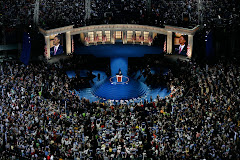Update: Obama received an Add-On superdelegate today as well, Vicky Harwell (Add-On-TN), and the tally for West Virginia is in, Clinton 20, Obama 8 pledged delegates. My count is that Obama now holds 286.5 superdelegates and 1600 pledged delegates (1886.5), projected to gain 49 pledged delegates next Tuesday in Oregon and Kentucky, which will give him the majority of pledged delegates and on record 6 more superdelegates, moving his total to 1942.5, not counting the Add-On's earned over the weekend and other unannounced superdelegates. That would leave a hard count at 82.5. Therefore projecting out Obama is expected to gather another 41 delegates from the remaining contests and the number reduces by half, where then he expected to get 27 more Add-On's and the number is reduced to 14. Count those superdelegates and each one brings this closer to the eventual lock.
Last night was disappointing but some astute political analysts are now figuring out this aberration of Obama's electorate and it is simply Appalachia. Here is a post from Talking Points Memo:
If the exit polls (and the pre-election polls) are accurate, Hillary Clinton is set to win West Virginia by roughly a 2 to 1 margin over Barack Obama. Oregon, next Tuesday, favors Obama. But Kentucky, which votes the same day, seems likely to yield a similar margin for Sen. Clinton. So what is it about these two states that makes them so favorable to Hillary Clinton?
There's been a lot of talk in this campaign about Barack Obama's problem with working class white voters or rural voters. But these claims are both inaccurate because they are incomplete. You can look at states like Virginia, Ohio, Pennsylvania and other states and see the different numbers and they are all explained by one basic fact. Obama's problem isn't with white working class voters or rural voters. It's Appalachia. That explains why Obama had a difficult time in Ohio and Pennsylvania and why he's getting crushed in West Virginia and Kentucky.
If it were just a matter of rural voters or the white working class, the pattern would show up in other regions. But by and large it does not.
In so many words, Pennsylvania and Ohio have big chunks of Appalachia within their borders. But those regions are heavily offset by non-Appalachian sections that are cultural and demographically distinct. West Virginia is 100% Appalachian. If you look at southeastern Ohio or the middle chunk of Pennsylvania, Obama did about the same as he's doing tonight in West Virginia.
Below is a map of the Appalachian counties stretching from New York down into Mississippi. Below that is a map of counties that Hillary Clinton has won by more than 65%. As you can see match up quite closely -- the grey gaps are Kentucky and West Virginia which hadn't voted yet.
So what is it about this region?Let me offer a series of overlapping explanations. First, some basic demographics. It's widely accepted that Hillary Clinton does better with older voters, less educated voters and white voters. These demographics perfectly match West Virginia -- and, more loosely, the entire Appalachian region. A few key points from tonight's exit polls demonstrate the point: 4 out of 10 voters were over 60 years of age. 7 out of 10 lacked a college degree -- the highest proportion of any electorate in the country. And 95% of the electorate was white.
Basically you have a state that is made up almost exclusively of Clinton's voters. But there's a deeper historical explanation that we have to apply as well -- one nicely illustrated by the origins of West Virginia itself.
During the 18th and 19th centuries, in the middle Atlantic and particularly in the Southern states, there was a long-standing cleavage between the coastal and 'piedmont' regions on the one hand and the upcountry areas to the west on the other. It's really the coastal lowlands and the Appalachian districts. On the other side of the Appalachian mountain range the pattern is flipped, with the Appalachians in the east and the lowlands in the west.
These regions were settled disproportionately by Scots-Irish immigrants who pushed into the hill country to the west in part because that's where the affordable land was but also because they wanted to get away from the more stratified and inegalitarian society of the east which was built by English settlers and their African slaves. Crucially, slavery never really took root in these areas. And this is why during the Civil War, Unionism (as in support for the federal union and opposition to the treason of secession) ran strong through the Appalachian upcountry, even into Deep South states like Alabama and Mississippi.
As I alluded to earlier, this was the origin of West Virginia, which was originally the westernmost part of Virginia. The anti-slavery, anti-slaveholding upcountry seceded from Virginia to remain in the Union after Virginia seceded from the Union. Each of these regions was fiercely anti-Slavery. And most ended up raising regiments that fought in the Union Army. But they were as anti-slave as they were anti-slavery, both of which they viewed as the lynchpins of the aristocratic and inegalitarian society they loathed. It was a society that was both more violent and more self-reliant.
This is history. But it shapes the region. It's overwhelmingly white, economically underdeveloped (another legacy of the pre-civil war pattern) and arguably because of that underdevelopment has very low education rates and disproportionately old populations.
For all these reasons, if you're familiar with the history, it's really no surprise that Barack Obama would have a very hard time running in this region.
--Josh Marshall









No comments:
Post a Comment